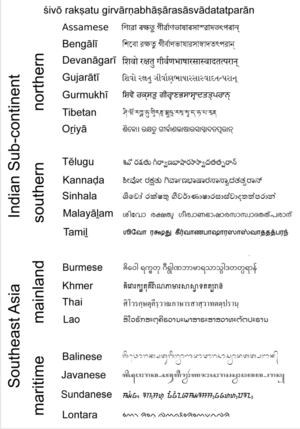History of Sanskrit (Writing system)
Writing system
This article is about how Sanskrit came to be written using various systems. For details of Sanskrit as written using specifically Devanāgari, seeDevanagari.
Sanskrit was spoken in an oral society, and the oral tradition was maintained through the development of early classical Sanskrit literature.[43] Writing was not introduced to India until after Sanskrit had evolved into the Prakrits; when it was written, the choice of writing system was influenced by the regional scripts of the scribes. Therefore, Sanskrit has no native script of its own.[2] As such, virtually all of the major writing systems of South Asia have been used for the production of Sanskrit manuscripts. Since the late 19th century, Devanagari has become the de facto standard writing system for Sanskrit publication,[44] quite possibly because of the European practice of printing Sanskritic texts in this script. Devanāgari is written from left to right, lacks distinct letter cases, and is recognisable by a distinctive horizontal line running along the tops of the letters that links them together.
The earliest known inscriptions in Sanskrit date to the 1st century BCE.[45] They are in the Brahmi script, which was originally used for Prakrit, not Sanskrit.[46] It has been described as a "paradox" that the first evidence of written Sanskrit occurs centuries later than that of the Prakrit languages which are its linguistic descendants.[45][47] When Sanskrit was written down, it was first used for texts of an administrative, literary or scientific nature. The sacred texts were preserved orally, and were set down in writing, "reluctantly" (according to one commentator), and at a comparatively late date.[46]
Brahmi evolved into a multiplicity of scripts of the Brahmic family, many of which were used to write Sanskrit. Roughly contemporary with the Brahmi, the Kharosthi script was used in the northwest of the subcontinent. Later (around the 4th to 8th centuries CE) the Gupta script, derived from Brahmi, became prevalent. From ca. the 8th century, the Sharada scriptevolved out of the Gupta script. The latter was displaced in its turn by Devanagari from ca. the 11/12th century, with intermediary stages such as the Siddham script. In Eastern India, theBengali script and, later, the Oriya script, were used. In the south where Dravidian languages predominate, scripts used for Sanskrit include Kannada, Telugu, Tamil, Malayalam and Grantha.
Romanisation
Main article: Devanagari transliteration
Since the late 18th century, Sanskrit has been transliterated using the Latin alphabet. The system most commonly used today is the IAST (International Alphabet of Sanskrit Transliteration), which has been the academic standard since 1888/1912. ASCII-based transliteration schemes have evolved due to difficulties representing Sanskrit characters in computer systems. These include Harvard-Kyoto and ITRANS, a transliteration scheme that is used widely on the Internet, especially in Usenet and in email, for considerations of speed of entry as well as rendering issues. With the wide availability of Unicode-aware web browsers, IAST has become common online.
It is also possible to type using an alphanumeric keyboard and transliterate to Devanagari using software like Mac OS X's international support.
European scholars in the 19th century generally preferred Devanagari for the transcription and reproduction of whole texts and lengthy excerpts. However, references to individual words and names in texts composed in European languages were usually represented with Roman transliteration. From the 20th century onwards, due to production costs, textual editions edited by Western scholars have mostly been in Romanised transliteration.



Comments
Post a Comment